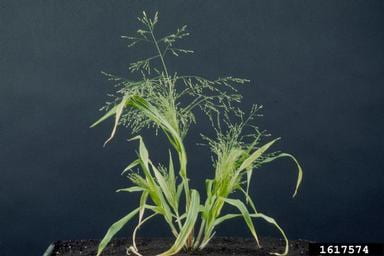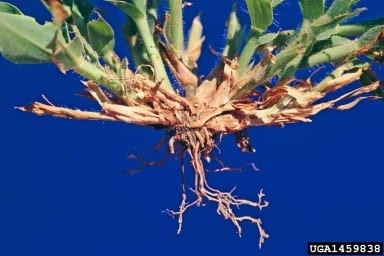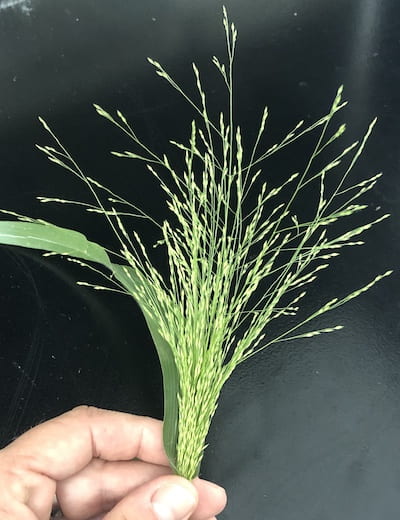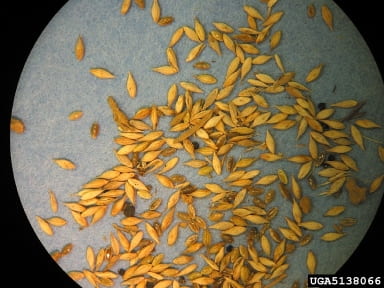Scientific name: Panicum capillare
Other name(s): old witch-grass, tickle-grass, witches-hair, tumble weed-grass, fool-hay
Witchgrass (Panicum capillare) is a common summer annual weed of field crops and small fruit in NYS. It can also be a weed in nursery crops, landscapes, roadsides, and gardens across a wide range of environmental conditions. Its most distinctive features are its dense coat of fine, soft hairs on stems and leaves and its large, feathery flowering heads.
Identification
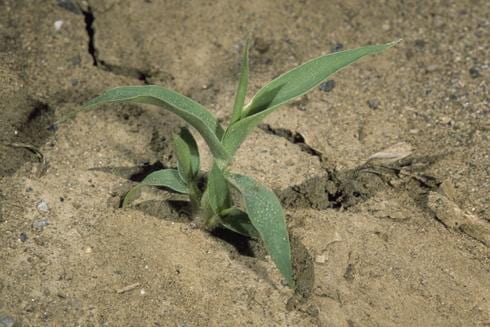
Witchgrass seedling.
Photo by Clyde L. Elmore via University of California Statewide IPM Program
Leaves:
Hair is present on top and bottom sides of the blades and margins of the leaves are rough. Each leaf blade has a distinctive white midrib down the center.
Leaf blade size: 4-10” (10-25 cm) long by 1/5-3/5” (0.5-1.5 cm)
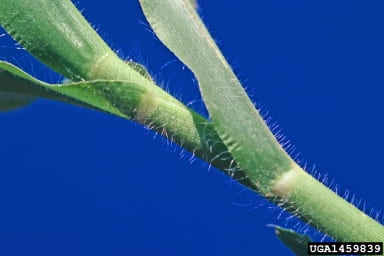
Close up of collar region of witchgrass.
Photo by Steve Dewey of Utah State University, via Bugwood.org
Mature plants: Leaves, hairs, and ligule of the mature plant are similar to those of the seedlings. Stem sheaths are slightly purplish, erect, and covered in long, stiff hairs. Mature plants can reach up to 0.9 m (3 ft) tall. The stems are round in cross-section and begin branching from the base of the plant. The root system is fibrous without taproot or rhizomes.
Management
Chemical control
Click above for the chemical control of Witchgrass from the Cornell Weed ID site
Use this tool to look up the efficacy of herbicides on a particular weed species. For general guidance on weed control, get the latest edition of the Cornell Crop and Pest Management Guidelines.
Non-chemical control
For management of this weed, spring tillage will increase the suseptibility of the witchgrass plant to becoming stale or to false seedbed management that terminates seedlings prior to planting summer crops. This is a viable method considering the germination of witchgrass seeds is encouraged by soil disturbance. Seedlings tend to grow from the top 1 inch of soil and develop slowly, thus, shallow, in-row weeding approaches are effective options. As this weed has a relatively high drought tolerance, it is also effective to bury young plants during cultivation. Also, excessive nitrogen fertilization will favor the witchgrass over crops, especially less competitive crops, so it is effective to avoid such excessive soil enrichment.
Similar species
Table 8: Compares the Panicums: fall panicum (Panicum dichtomiflorum), switchgrass (Panicum virgatum), and witchgrass (Panicum capillare) illustrating their similarities and differences.
| Species | Fall panicum (Panicum dichtomiflorum) | Switchgrass (Panicum virgatum) | Witchgrass (Panicum capillare) |
|---|---|---|---|
| Similarities | Summer annual; leaf bud rolled; no auricle; ligule fringe of hairs; fibrous root system | Leaf bud rolled; no auricle; ligule fringe of hairs | Summer annual; leaf bud rolled; no auricle; ligule fringe of hairs; fibrous root system |
| Differences | Seedling leaf sheaths are densely hairy, blades are hairy on lower surface; mature blades and sheaths are smooth on both surfaces. | Perennial; leaf blade is hairy on upper side; sheath is hairy at margins; it produces rhizomes | Seedling sheath, blade, and collar are densely hairy; on mature plant, leaf blades on both surfaces and leaf sheaths are densely hairy |
Herbicide resistance
Reported as of 2021:
North America
Canada
Group 5 (Ontario)
Other continents
None
For a more detailed report, please visit the reference section below or visit the International Herbicide-Resistant Weed Database homepage for more information about resistance.
References
Uva R H, Neal J C, DiTomaso J M. 1997. Weeds of the Northeast. Book published by Cornell University, Ithaca NY. The go-to for weed ID in the Northeast; look for a new edition sometime in 2019.
Cornell University’s Turfgrass and Landscape Weed ID app. Identification and control options for weeds common to turf, agriculture, and gardens in New York; uses a very simple decision tree to identify your weed.
Organic management suggestions are from Dr. Charles Mohler of Cornell University. Look for an upcoming book from Dr. Mohler on ecological management of weeds, from Cornell University Press.
University of California’s Statewide Integrated Pest Management Program’s profile page for witchgrass. Page provides identification information for the different stages and components of the witchgrass plant.
University of Missouri’s Division of Plant Sciences’ profile page for witchgrass. Provides concise identification information and multiple images of the plant’s different life stages.
Herbicide resistance details
North America
Canada
Province of Ontario, group 5 (atrazine)
Other continents
None






